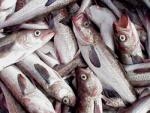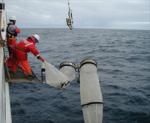The Bering Sea is one of the most productive marine ecosystems in the world, sustaining nearly half of U.S. annual commercial fish landings and providing food and cultural value to thousands of coastal and island residents. In 2007 the North Pacific Research Board (NPRB) and the National Science Foundation (NSF) entered into a partnership to support the Bering Sea Project, a comprehensive $52 million investigation to understand how climate change is affecting the Bering Sea ecosystem, ranging from lower trophic levels (e.g., plankton) to fish, seabirds, marine mammals, and ultimately humans. The project integrates two research programs, the NSF Bering Ecosystem Study (BEST) and the NPRB Bering Sea Integrated Ecosystem Research Program (BSIERP), with substantial in-kind contributions from the National Oceanic and Atmospheric Administration (NOAA) and the U.S. Fish and Wildlife Service (USFWS) (See Witness Spring 2007).
The six-year BEST-BSIERP study includes 43 projects and links nearly one hundred principal scientists. The investigative field studies are tied together with a fully integrated modeling program. The overall goal is to define the mechanisms that create and sustain this highly productive ecosystem, and to understand how those mechanisms may be altered as the climate changes. The study focuses on three overarching research themes:
Control of Production in a Changing Environment – Examining the timing and duration of seasonal production (i.e., generation of biomass through plants and animals) and its effect on ecosystem components (i.e., benthic [seafloor] communities versus pelagic [open ocean] communities). The extent of sea ice and the timing of its retreat is a key control in Bering Sea production.
Competition Among Consumers – Examining how major consumers (e.g., walleye pollock and arrowtooth flounder) of production compete over time, and how this competition influences the short-term (3-5 year) and medium-term (10-30 year) success of various groups.
Location Matters – Examining how climate-driven changes in the spatial distribution of production may affect place-based foragers (e.g., seabirds and fur seals) versus more mobile foragers (e.g., whales).
2010 Activities
The Bering Sea Project is currently in its third and final year of field activities, which has included integrated field sampling and process studies in an area that spans the southeastern Bering Sea shelf from the Aleutians north to St. Lawrence Island and from the shallow inner shelf (40 m depth) to the deep continental slope (2000 m depth). In 2010, from January to September, six research vessels supported 11 research cruises. Ship-based studies have included observations on populations of phytoplankton, zooplankton, ichthyoplankton (young fish); distribution of foraging sea birds; predator dynamics in relation to food supply distribution; groundfish; and hydrography.
Research Highlight: Pollock
One research topic studied this year and in previous years is the distribution and abundance of pollock in the Bering Sea.


Initial findings from the study include the following:
Survival of larval pollock is enhanced during warm spring conditions, but high temperatures in late summer and fall are associated with reduced recruitment the following year, which may foretell reduced pollock abundance in the future.
Despite overall warming trends, the Northern Bering Sea will likely remain arctic (i.e., ice-covered and cold) for the next 25-30 years. Even during the warm years from 2001-2005, temperatures were only slightly warmer in this area compared to the recent cold years from 2006-2009.
Seabirds shift foraging locations in response to juvenile pollock abundance (http://bsierp.nprb.org/fieldwork/2010/pollock-acoustic.html).
Future Activities
Following the 2010 cruises, the project will transition from data collection to the synthesis phase. The final years of the project (2011-2012) will focus on data analysis, reporting on results through peer-reviewed publications, special journal issues focused on synthesis, and development of conceptual and mathematical models (http://bsierp.nprb.org/results/publications.html). The Bering Sea Project will also provide scientific advice to the North Pacific Fishery Management Council, which oversees management of the fisheries in the Bering Sea, Gulf of Alaska, and Aleutian Islands.
For more information, see the Bering Sea Project website: http://bsierp.nprb.org/index.html or contact Michael F. Sigler (Mike.Sigler [at] noaa.gov), H. Rodger Harvey (harvey [at] umces.edu), or Thomas I. Van Pelt (tvanpelt [at] nprb.org).
